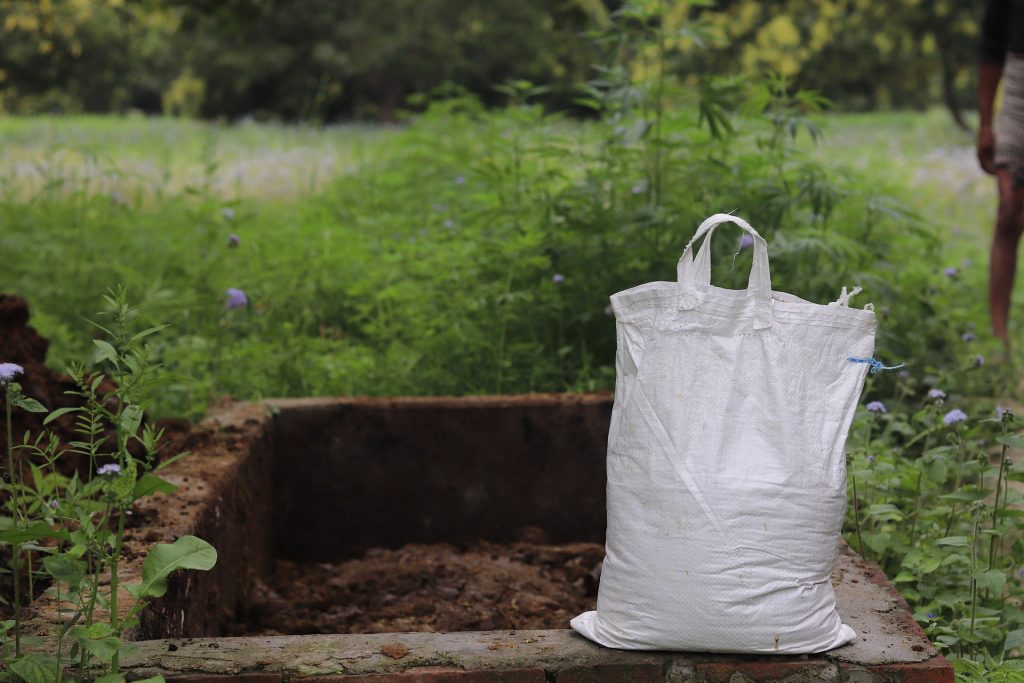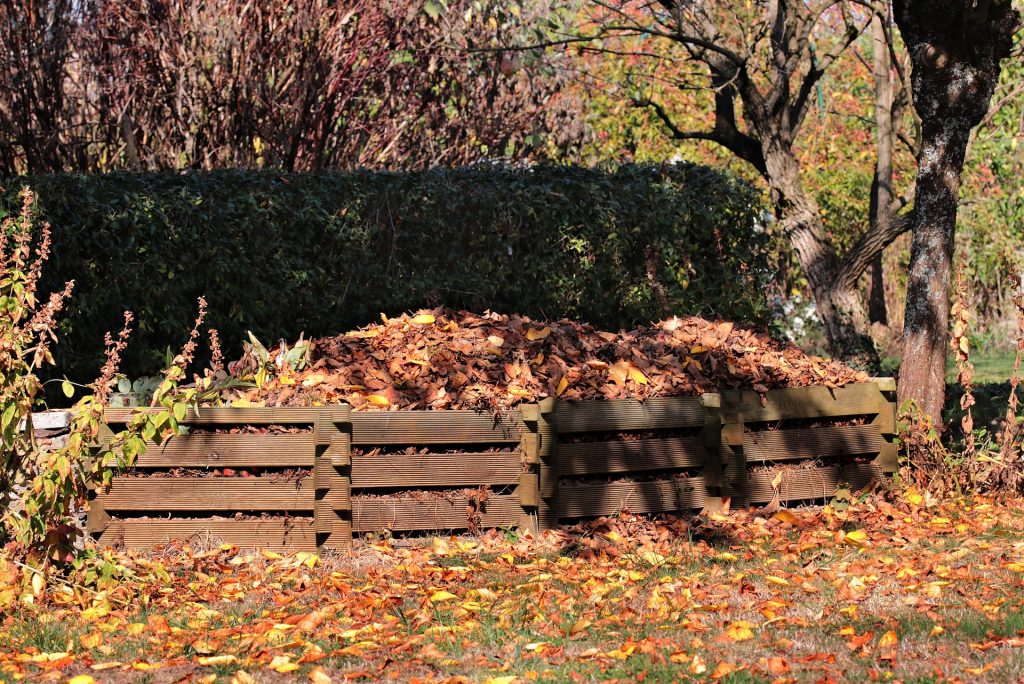It’s great that you want to find an efficient way to dispose of the organic waste and make it organic compost, we totally understand that you don’t wish to buy a new compost bin. Not everyone is willing to spend a few hundred dollars on purchasing a new composter. If you still want to own a compost bin but don’t want to spend much, then you can consider building one yourself.
5 Ways to Create DIY Compost Bins
Here are five tried and tested methods with step by step instructions to build an indoor compost bin or yard composting at home.
Build Two-Bin Compost Bin
It’s more than easy to build a two-bin compost bin.
- You’d need some leftover lumber or you can buy few blocks of lumber at a cheap price.
- Stack and nail the lumber in the size of a box.
- Consider keeping the size of these bins 3 feet by 3 feet in diameter and 2 feet tall. (You can reduce or expand the size as per your requirement).
- If you have carpentry skills, you can get it done within an hour. You can use metal mesh stacked on a four-piece of lumber as the cover.
Build Three tired worm compost bin
The worm compost bin is a very popular choice for a compost bin. Also known as vermicomposting or worm composting, the worms help decompose the food and yard waste into a nutrient-rich soil compost pile. The worm composting process is also helpful in creating a nutrient-rich compost pile.
Items required
- Power drill
- Hole saw set
- Drill bit 6 mm / 0.23 inches
- Jigsaw or strong scissors (optional)
- 3 stackable plastic bins of the same size
- 1 lid or / plastic sheet / Plastic container
- 1 tap or cork
Step by Step Instructions
- Start with drilling plenty of holes (6mm) into the bottom of the two bins which will house the worms. Remember to keep each hole 5cm apart from each other.
- Next, drill a hole for a tap into the front side of the third bin. Drill the hole for the tap as low on the wall of the worm bin as you can, but leave enough space so you can fasten the nut of the tap inside the bin to ensure a tight fit. Then, attach the tap. (You can also use a wine bottle cork as the tap)
- Next, you’d need a lid to cover the bin. If the bin isn’t fitted with a lid, you can build one using a plastic sheet. Measure the sheet against the opening of the bin and cut it carefully. Now, assemble the bin and cover it with the plastic sheet. Remember to keep the worm farm away from the full sun as it can cause serious problems for your worms on a hot day. You’re done with the worm composting bin.
Build Five Gallon Bucket Compost Bin
It’s perfect for backyard composting. It’s easy to get your hands on a 5-Gallon Bucket at home. The items needed for this compost bin include;
- One 5-Gallon Bucket with a tightly fitting lid or wine barrel
- Small sticks for drainage.
- A drill and a medium-large sized bit (hammer and nail)
- Green and Brown – Fruit and vegetable scraps, food scraps, kitchen scraps, coffee grounds, egg-shells, grass clippings, shredded paper, local grocery, cardboard, straw, etc.
- A trash can or a stainless steel compost bin.
- Start with drilling holes (almost 10 drill holes) in the lower half of the bucket and the lid. This will help the moisture to drain out.
- Place several sticks in the bottom of the bucket to ensure that the bottom drainage holes don’t get clogged.
- Start dumping food and yard scrap into the bin. Don’t fill the bucket too full. It will help to aerate the pile.
- Press the lid tightly over the bucket and press it onto the ground. Roll or shake the bucket each time you add it to your compost pile.
Build Up-cycled Cardboard Box Compost Bin
An up-cycled cardboard box compost bin is easy to make. You can use cardboard used for packing goods in the shopping malls.
Items needed
- 1 x Cardboard bulk box
- All food scraps
- Weeds and yard prunings
- Leaves
- Wire mesh
- Newspapers and plain cardboard
- A bit of soil
Choose an outdoor location for your compost bin. Try to keep it somewhere shaded, as composting doesn’t require sunlight.
- Find a flat, level ground.
- Keep the lips of the cardboard up. Set it up neatly, using bricks or concrete blocks.
- Once you start pouring in the food scraps, vegetable matter, green materials, shredded newspaper, weed seeds, and other organic waste or organic materials, it will take the necessary shape.
- Remove the bricks or concrete blocks away afterward.
Cardboard compost bins have a lifespan of about a year, depending on the weather and how they’re set up. When your bin starts to fail, get yourself a new one.
Build Drum Style Compost Bin
The drum-styled compost bin resembles a DIY compost tumbler. The bin can rotate which helps to stir the compost material to make the finished compost breathable.
Items needed
- 2-Plywood 2′ X 2′
- Fence wire 3′ X 62 (Try to use a fine mesh–mine is ~1/4″)
- 1–2 X 4 X 92-5/8″
- 1–1 X 4 X 48″
- PVC 3/4″ X ~35″
- ~49″ Rebar
- Nails, staples, glue
- Measuring tape
- Circular Saw
- Sabre Saw
- Drill
- Hammer
- Start with cutting the plywood into a circle with a 10 1/2″ radius. Cut 2–2 X 4 to 26″. Cut 2–1 X 4 to 24″. Cut PVC to 35″.
- You can use a wire mesh measuring 3 feet wide and ~62″ long. The crossbeam that goes over the hub should be cut to size based on the size of your drum.
- Build a stand by nailing and gluing 2×4 (vertical) woodblock and 1×4 (footing) woodblock.
- Create a drum section by running rebar through round cut plywood, PVC, and through the stand. Staple wire to round cut plywood. Measures the sizes for the cross beams and nail/glue them to the vertical supports.
- Finish it by proofing the open wire mesh and wood splinter.
Now you can add composting materials like food and yard scrap, kitchen waste, dry leaves, grass clippings, straw bales, wood chips, matted leaves, vegetable peelings, and other carbon-based material waste into it.
Things to Remember while making a compost bin yourself
Before deciding to build one, you must be wary about the materials, contents, size, and temperature required for any functioning compost bin.
Let’s answer all of these questions here.
What kind of material can I use to build a compost bin?
You can use scrap wooden pallets, durable plastic jars, straw bales, wine barrels, or anything sturdy to build a compost bin. Remember, the temperature inside the bin is always higher than the temperature outside; hence you should use a sturdy material like a wine barrel that can help keep the temperature inside the bin regulated.
What should I put at the bottom of the compost bin?
If you’re placing the compost bin on open soil, there’s no need to place anything at the bottom. If you’re placing the compost bin inside the house such as for the kitchen compost bin, you should the same material that you used for the bin as the bottom.
What can I do to repel rodents and insects from the compost bin?
It’s easy for rodents and insects to pilfer into your compost bin if it’s not properly latched or covered. The poorly designed bin with a loose opening or cracks can easily attract rodents and insects. The smell of the content can also attract small animals; hence avoid composting items like meat, bones, fish, etc.
To deter small animals, you can line the base, sides, and top of the kitchen compost bin with a heavy-duty metal mesh.
When can I use my compost bin?
You can start composting at any time of the year. The food and yard scraps decompose faster in warmer weather. Autumn is a popular time to start composting because the gardeners begin tidying up their garden. You can start by composting yard scraps. If you’re not doing outdoor compost, you can set up one as a kitchen compost bin. The step instructions are provided above.
How do insects enter the compost bin?
The insects will enter the compost bin from the bare soil located just below the bin. If you keep the bottom open on bare soil, beneficial insects like earthworms and other organisms will move into your worm compost bin to help expedite the decomposition process.
What are the best conditions for a compost heap?
A compost heap will start decomposing efficiently when it gets some sunshine during the day. The heat will help to warm up the composting organisms for the composting process.
Should I cover the compost bin?
Closing the top of the compost bin helps to regulate the temperature and moisture inside. You can use anything from a piece of carpet, polythene, or scrap woods to cover the top. Drilling the ventilation holes on the bin isn’t necessary.
If you feel building a compost bin or tumbler is hard work, you can buy one for yourself after carefully choosing the best compost bin from our recommendation.


Leave a Reply